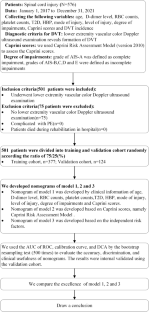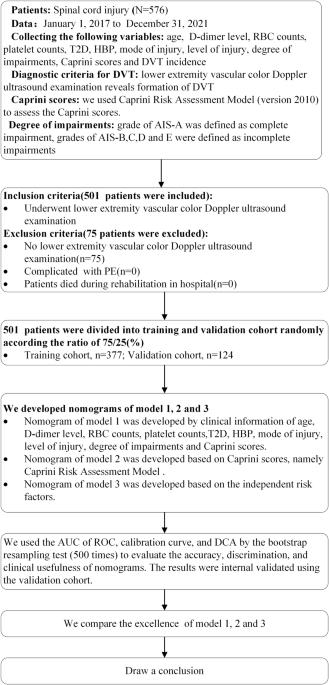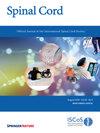Development and validation of a novel screening tool for deep vein thrombosis in patients with spinal cord injury: A five-year cross-sectional study
IF 2.2
4区 医学
Q3 CLINICAL NEUROLOGY
引用次数: 0
Abstract
Cross-sectional study. Deep vein thrombosis (DVT) presents a significant risk of complication in patients with spinal cord injury (SCI), necessitating accurate screening methods. While the Caprini Risk Assessment Model (Caprini RAM) has seen extensive use for DVT screening, its efficacy remains under scrutiny. First Affiliated Hospital of China University of Science and Technology. We created and evaluated three nomograms for their effectiveness in DVT screening. Model 1 incorporated variables such as age, D-dimer level, red blood cell (RBC) counts, platelet counts, presence of type 2 diabetes mellitus, high blood pressure, mode and level of injury, degree of impairments, and Caprini scores. Model 2 was derived from Caprini scores alone, and Model 3 focused on independent risk factors. We assessed these models using the area under the curve (AUC) of the receiver operating characteristic (ROC), calibration curves, and decision curve analysis (DCA), employing bootstrap resampling tests (500 iterations) to determine their accuracy, discriminative ability, and clinical utility. Internal validation was performed on a separate cohort. Nomogram was established with well-fitted calibration curves for model 1, 2 and 3(AUC = 0.808, 0.751 and 0.797; 95%CI = 0.76–0.86, 0.70–0.80 and 0.75–0.84; respectively), indicating model 1 outperformed the others in prediction DVT risk, followed by model 3 and 2. These findings were consistent in the validation cohort, with DCA further corroborating our conclusions. A nomogram integrating clinical data with Caprini RAM provides a superior option for DVT screening in SCI patients within rehabilitation settings, outperforming Caprini RAM.


脊髓损伤患者深静脉血栓形成新型筛查工具的开发与验证:一项为期五年的横断面研究。
研究设计横断面研究:深静脉血栓形成(DVT)是脊髓损伤(SCI)患者并发症的重要风险因素,因此需要准确的筛查方法。虽然卡普里尼风险评估模型(Caprini RAM)已被广泛应用于深静脉血栓筛查,但其有效性仍有待商榷:地点:中国科学技术大学附属第一医院:我们创建并评估了三个提名图在深静脉血栓筛查中的有效性。模型 1 包括年龄、D-二聚体水平、红细胞(RBC)计数、血小板计数、是否患有 2 型糖尿病、高血压、受伤方式和程度、损伤程度和 Caprini 评分等变量。模型 2 仅根据卡普里尼评分得出,模型 3 侧重于独立的风险因素。我们使用接收器操作特征曲线(ROC)的曲线下面积(AUC)、校准曲线和决策曲线分析(DCA)对这些模型进行了评估,并采用自举重采样测试(500 次迭代)来确定其准确性、判别能力和临床实用性。内部验证在一个单独的队列中进行。这些结果在验证队列中是一致的,DCA进一步证实了我们的结论:整合了临床数据和 Caprini RAM 的提名图为康复环境中 SCI 患者的深静脉血栓筛查提供了更优越的选择,其效果优于 Caprini RAM。
本文章由计算机程序翻译,如有差异,请以英文原文为准。
求助全文
约1分钟内获得全文
求助全文
来源期刊

Spinal cord
医学-临床神经学
CiteScore
4.50
自引率
9.10%
发文量
142
审稿时长
2 months
期刊介绍:
Spinal Cord is a specialised, international journal that has been publishing spinal cord related manuscripts since 1963. It appears monthly, online and in print, and accepts contributions on spinal cord anatomy, physiology, management of injury and disease, and the quality of life and life circumstances of people with a spinal cord injury. Spinal Cord is multi-disciplinary and publishes contributions across the entire spectrum of research ranging from basic science to applied clinical research. It focuses on high quality original research, systematic reviews and narrative reviews.
Spinal Cord''s sister journal Spinal Cord Series and Cases: Clinical Management in Spinal Cord Disorders publishes high quality case reports, small case series, pilot and retrospective studies perspectives, Pulse survey articles, Point-couterpoint articles, correspondences and book reviews. It specialises in material that addresses all aspects of life for persons with spinal cord injuries or disorders. For more information, please see the aims and scope of Spinal Cord Series and Cases.
 求助内容:
求助内容: 应助结果提醒方式:
应助结果提醒方式:


